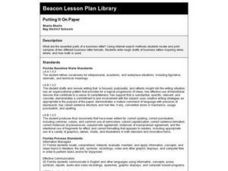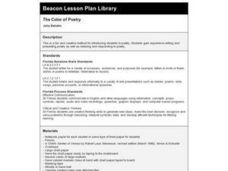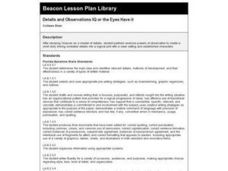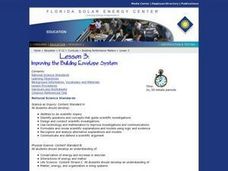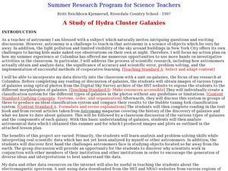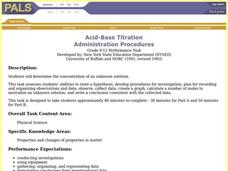Curated OER
Portfolio Power
Learners explore how portfolios are a marketing tool for job seeking. In this employment lesson, students identify parts of a professional portfolio and the importance of having one as a perspective employee.
Curated OER
Putting it On Paper
Learners locate and print samples of two different business letter formats. They write rough drafts of business letters inquiring when, where, and how math is used.
Curated OER
The Teller of the Tale, Part 2
Students discuss character types and their qualities. They select two characters and write about their dress, speech, habits, attitudes and beliefs. They write a monologue as the characters presenting a moral theme.
Curated OER
The Color of Poetry
Students listen to a story about colors and then write their own color poems.
Curated OER
Details and Observations IQ or the Eyes Have it
Fourth graders study Chaucer as a master of details. Then, they create a short story linking unrelated details into a logical plot with a clear setting and established characters. This lesson has some excellent worksheets attached!
Alabama Learning Exchange
Getting to Know You
First graders go on an in-school scavenger hunt to get to know the many kinds of people that make up an elementary school community. They work in small groups and use digital cameras to take pictures of the workers they find.
Curated OER
Improving the Building Envelope System
Students explain the different heat transfer mechanisms and how they influence the building envelope. They develop ways in which the building envelope can be improved and test hypotheses about building envelope designs.
Curated OER
A Study of Hydra Cluster Galaxies
Students analyze a designated galaxy with a partner or in a small group.
Curated OER
You Are Smarter Than The Ads
Fourth graders examine advertising techniques and create original designs for advertisements in this three day, 4th grade art/social studies lesson. The lesson includes assessment ideas, resource information, and learning objectives.
Curated OER
Acids and Bases: Together again!
Young scholars identify principles behind acid-base reactions. They predict factors that may affect an acid-base reaction. Students identify questions and concepts that guide scientific investigations.
Curated OER
Enduring Understanding
Fourth graders explore indigenous people of rainforest and examine their customs and ways of life. They discuss how rainforests should be protected not only for their plants and animals, but also for indigenous people who live in them,...
Curated OER
Substitution Formula
In this substitution formula learning exercise, students solve 9 various types of problems related to applying the substitution formula. First, they use a number line to add or subtract negative integers. Then, students substitute...
Curated OER
Amazonian Travel Brochure
Students create a brochure. In this Amazon research lesson, students research a tourist attraction in the Amazon and develop a travel brochure.
Curated OER
Responding to Open-Ended Questions using RASP
Young scholars learn how to answer questions correctly. In this writing lesson, students learn the acronym RASP and view model responses for each part of the writing strategy. Young scholars practice using the RASP model to...
Curated OER
Classification of Cerealites
Students create a dichotomous key. In this categorizing lesson, students create a dichotomous key for different types of cereal. Students classify the cereal into groups such as flakes and cereal with holes. Students discuss their...
Curated OER
Adapting a Musical
Students transform literature into musical productions. In this integrated arts lesson, students discuss how musicals are written and produced. Students then select literature they are familiar with to adapt into musical productions.
Curated OER
Frozen, Canned or Fresh?
Students compare spinach. In this Science lesson, students construct an experiment to test fresh, frozen, and canned spinach taste and texture. Students record their findings in charts and graphs.
Curated OER
Simple Harmonic Motion with Dr. DAQ
Students study the work and accomplishment of Galileo. In this physics lesson, students calculate the period of a pendulum's using a mathematical equation. They explain the different factors affecting its period.
Curated OER
Testing the Hypothesis
Students create and conduct various experiments to determine the origin of a family artifact, and then determine whether their results were successful. Students summarize their results and evaluate whether their hypotheses were correct.
Curated OER
Coffee Cooling
High schoolers explore the factors that affect how long coffee stays hot. They develop a question and a testable hypothesis for one factor such as initial temperature or size of opening of the container. Then they design and conduct an...
Curated OER
The effectiveness of Antacids
Students design and conduct a scientific experiment to test which of four antacids would be most effective for neutralizing acids. They rank the antacids in order from most effective to least effective and explain how they determined...
Curated OER
That's the Way the Ball Bounces
Young scholars investigate and compare the bouncing ability of the materials from which four different balls are made. They determine which material performs the best for use as a basketball. After collecting data in a small group they...
Curated OER
Coat Caper
Students examine pollen and fibers taken from a garment. They analyze pollen from new hybrids and compare it to the samples from the garment then make individual conclusions concerning the specific historical authenticity of the garment.
Curated OER
Acid-Base Titration
Students determine the concentration of an unknown solution. This task assesses students' abilities to state hypothesis, develop procedures for investigation, plan for recording and organizing observations and data, collect data, create...



